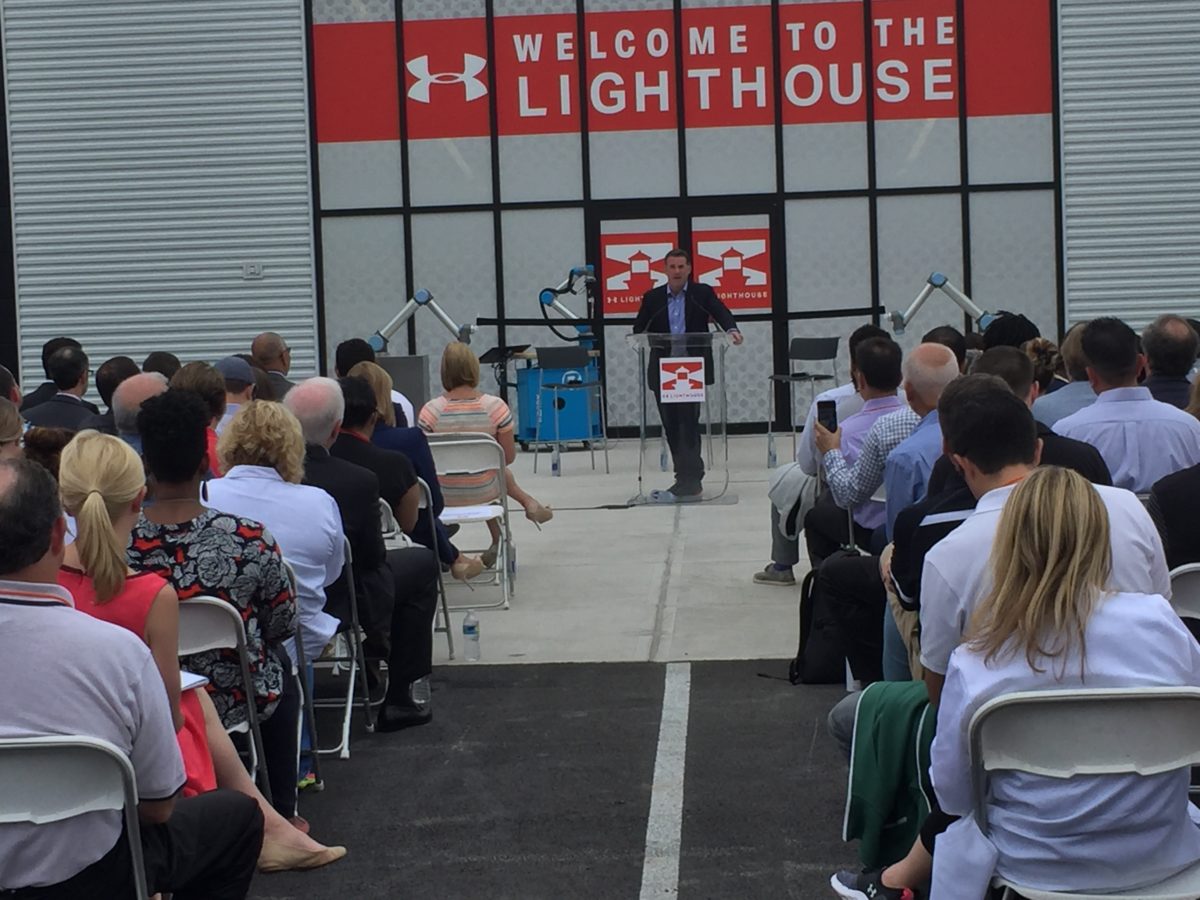With game-changing athletes wearing their stuff and commercials that send chills, Under Armour is maybe inching closer to reaching its goal: being a cutting-edge brand. But as Kevin Plank and co. look to the future, they’re betting on a bunch of white coats tinkering in a lab.
While talking about the redevelopment of Port Covington, Plank has spoken passionately about bringing manufacturing jobs back to the U.S. through a program called local-for-local. The idea is to develop advanced manufacturing processes that can be done in U.S. cities like Baltimore, and employ local people. He’s also spoken about beating the competition to a 3D-printed shoe, which happened in March.
Kevin Plank led countdown, but ribbon cutting left to something else at @UnderArmour manufacturing innovation center pic.twitter.com/mtzNSt6B8e
— Technical.ly Baltimore (@TechnicallyBMR) June 28, 2016
The Lighthouse, which occupies a 35,000-square-foot area in the south portion of the Port Covington innovation hub at City Garage, is the place where both of those ideas come together.
Walled off from the massive former bus garage’s space for Baltimore startups and makers, the lab feels about as far away from a sports arena as an apparel company could get.

That’s a lot of CNC. (Photo by Stephen Babcock)
The giant doors that were thrown open to reveal the space after an intro video Tuesday (and all those folks in white coats) give the whole thing a science-fiction feel. But for Under Armour it all comes back to the very tangible margins of making shirts and shoes. The experts are working on efforts such as reducing the number of people involved in manufacturing the upper of a shoe, or modeling athletes for custom-fitted apparel through imaging.
When Under Armour’s headquarters moves from Locust Point into this neighborhood, the idea is to make The Lighthouse a place where the company’s design and manufacturing teams can come together to consider new processes. From there, the ideas would flow into Under Armour’s network of factories and the rest of the supply chain.
“It’s that place between the design and manufacturing that’s going to lead us to a place that nobody’s been able to get to in the last decade,” Kevin Haley, UA’s president of product and innovation, said at Tuesday’s opening ceremony.

UA’s path to changing manufacturing. (Photo by Stephen Babcock)
To lay the groundwork for the development of these processes, Under Armour brought in local partners like 3dMD and the University of Maryland’s Engineering Department, as well as big companies like Dow Chemical (now DowDuPont), Bemis, Epson, Lectra and Desma.
Here are the four areas of production where the company is focusing:
3D Imaging

NFL wide receiver Torrey Smith gets scanned. (Photo by Stephen Babcock)
Using body scanning, the company wants to speed up the process of custom-made apparel, and get more specific about the specifications for its athletes.
NFL wide receiver Torrey Smith provided a look at the 54-camera body scanner. By using the scans and virtual designs, the company has to visit the athletes fewer times, and can also monitor changes to their body and get more exact about specifications.
3D Printing

3D Printing Room?! (Photo by Stephen Babcock)
The Lighthouse is equipped with fabrication and machining tools to create models of new UA goods. They’re equipped for subtractive and additive manufacturing. A five-axis machining center was especially impressive.
Prototyping

(Photo by Stephen Babcock)
The Lighthouse is about changing existing methods as well as creating new products. The company will look to reconsider production methods for an individual product. For instance, one area is producing sew-free garments.
The main areas the company wants to see change are in speed, quality and cost. With robots and advanced sewing equipment, the company wants to reduce the number of people required to assemble a product.
Pilot Lines
This is where the new processes will be tested.
When considering the scale necessary for a massive company like Under Armour, this area will evaluate how the new processes will look on the line. For instance, Under Armour got attention for taking inspiration from bras in designing its Speedform shoes. But the line also represented a step forward in manufacturing efficiency, with each shoe consisting of about 13 pieces. The industry average is 55.

(Photo by Stephen Babcock)
There’s also an area behind a red curtain, but it’s top secret.
Before you go...
Please consider supporting Technical.ly to keep our independent journalism strong. Unlike most business-focused media outlets, we don’t have a paywall. Instead, we count on your personal and organizational support.
Join our growing Slack community
Join 5,000 tech professionals and entrepreneurs in our community Slack today!

The person charged in the UnitedHealthcare CEO shooting had a ton of tech connections

From rejection to innovation: How I built a tool to beat AI hiring algorithms at their own game

Where are the country’s most vibrant tech and startup communities?


